Between 1915 and 1934, the United States led a military occupation of Haiti and essentially controlled the country’s government and economy. During the period between 1911 and 1915, Haiti experienced political instability with the assassination or removal of a half-dozen presidents and growing investments from German traders, a fact which greatly unsettled the United States. From a tactical standpoint, the United States considered Haiti a prime location for a military installation. While in control, American leaders essentially ran the government and oversaw the passage of a national constitution which permitted foreign land ownership, something which had been disallowed in Haiti since its founding. During the near twenty-year occupation, the United States employed a number of civilians as interpreters and informants. Louisiana was a natural source for such persons, due to its Francophone community which included individuals on both sides of the color line.
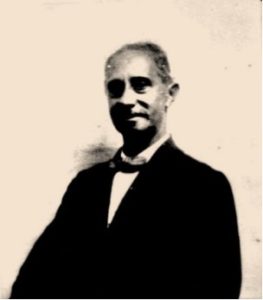
Paul Dominguez
Two New Orleans-born Creoles of color, Paul Dominguez, Sr. and Edward LaMothe, were among those employed by the Office of Naval Intelligence. There was some degree of secrecy attached to their roles, inasmuch as their purposes for traveling to Haiti were intentionally reported as to “visit relatives,” or for “business,” rather than working for the intelligence service. The opportunity to engage in government work was a plum for these men, who already made their living in skilled trades as a cigar maker (Dominguez) and building contractor (LaMothe). Both men likely knew that they had roots, either personal or communal, in colonial Saint-Domingue, which became Haiti.
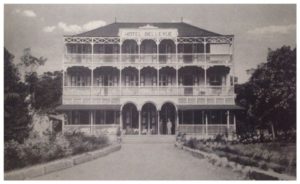
Hotel Bellevue, Port-au-Prince
Paul Dominguez, Sr. was born in New Orleans 1862 to the Mexican-born shoemaker Andre Dominguez and Louise Whittaker. His paternal grandparents were Alcide Dominguez and Adelaide Petit. Paul Dominguez was married to Rita Diaz, the daughter of Joseph Diaz, Jr. and Josephine Charles. Together, they had three children: Andre Dominguez; Virginia Dominguez; and Paul Dominguez, Jr., who was a pioneering Jazz violinist. A cigar maker by trade, Paul Sr. was also a classically-trained string player. Paul Dominguez, Sr. served on the board of directors of the Institute Catholique des Orphelins Indigents or the Catholic Indigent Orphans Institute, which was established in 1847 by bequest of free woman of color, Marie Justine Cirnaire Couvent. He also was the reputed ‘king’ of the “Boat” lottery, one of the largest numbers games which existed.
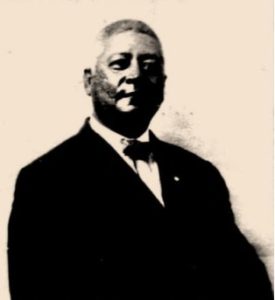
Edward Lamothe, contractor and father of Jelly Roll Morton
Edward LaMothe was born in New Orleans in 1865 to Martin LaMothe and Henriette Jaillot. By all accounts, Ed LaMothe was a successful contractor who also owned several properties himself. He was the father of twelve children, the most notable of whom was Ferdinand Joseph LaMothe, who would become famous the world over as Jelly Roll Morton.
The impressions of Haiti of these two native-born New Orleanians might be shrouded in as much mystery as their intelligence work were it not for a few letters buried in the archives of the Supreme Council of Louisiana, Ancient and Accepted Scottish Rite Freemasons, which are housed in the George Longe Papers at the Amistad Research Center.
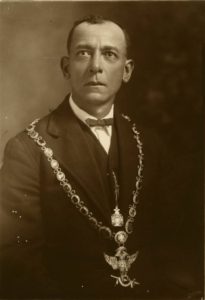
George Ulysses Maury, Sovereign Grand Commander, Supreme Council of Louisiana
Paul Dominguez was a Scottish Rite Mason and addressed three surviving letters (all from 1918) to the Sovereign Grand Commander, George U. Maury, and other members of the Supreme Council. The letters reflect that Dominguez sought out his Masonic brothers in Port-au-Prince and through them met the President of Haiti Philippe Sudré Dartiguenave, who also served as the Sovereign Grand Commander. Dartiguenave, who carried out many internal improvement projects during his presidency, also bore the title of Grand Protecteur de l’Ordre. Dominguez was in attendance when that title was conferred and described it as “the most sublimed ceremony of which I attended.” He visited L’Amitié Lodge No. 47 and reported that he was well received, according to his degree.
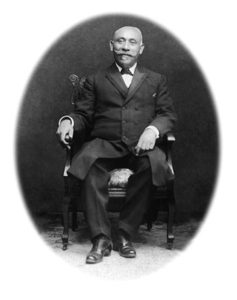
President Philippe Sudré Dartiguenave
The most revealing of the letters was dated 14 February 1918 and was sent to Henry Potin by way of Albert Monnot, who were both Masons as well. Dominguez set out to give his friends “a few details of Haiti,” and as he wrote, “All the critics that you have heard is not half of what it is.” Dominguez wrote with the syntax of one whose mother tongue was not English:
Just imagine they was a fire and the firemens refuse to go saying this: “Mo las yo pas besoin pompe. [”I’m tired. They don’t need a pump.”]
I was some time ago to the juge-de-paix [justice of the peace]. He wrote a few lines and for blotting paper he went in the middle of the street and pick up a handful of dust and spread it on the ink.
They have steam cars old Spanish Fort dummies that used to run 40 years ago, and if you remember them old dummies is that use to go to Carrollton about 30 years ago, that’s what they use now. All day the engineer is picking small pieces of wood on the street to steam up. One day I was riding in one of them [and] the engine stop I asked a lady what was the matter she told me this: “Car yo malade. Li gain derangement. Yo massé papier et bois dans chemin yo pou fait li maché.”[The car is not working. They are putting paper and wood from the street to make it go.”]
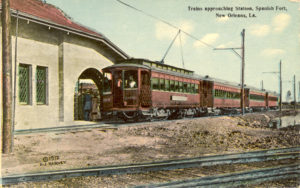
Spanish Fort “Dummy Cars”
All the mens that was introduce to me was ex-President, ex-Deputy, ex-Minister, ex-General all Haiti is ex. A person that works is a disgrace; all is professional mens such as lawyers, judges, physicians, and druggists.
There is also a bank that employs 100 mens, a bank like on Claiborne and St. Ann Street. Four good men could run the bank but it takes one hundred men to run that bank. It takes a whole day for a person to deposit fifty dollars. I will only give you an idea. You must tell where you are working; bring your boss with you; ‘How long you expect to leave that amount in bank’ ‘How long it took you to save that amount,’ and a hundred questions of that sort.
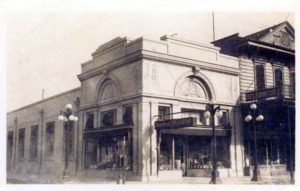
Tremé Market Branch Bank, North Claiborne at Saint Ann
All the poor class is the barefooted and most naked. Well there is a fine class of people that was educated in France, they speak good French and that’s all. Barefoot and a cravat, walking cane – that’s the style. … It would take me a week to relate to you all.
Even for this lifelong New Orleanian, accustomed to the easy pace, provinciality, and sometimes backwardness of his city, he found much to be intriguing and much to remark about in Port-au-Prince, its sister city in the Caribbean.
Paul Dominguez and Edward LaMothe’s work in Haiti must have been well-known in the city. LaMothe’s brother-in-law, Henry Monette (maternal uncle of Jelly Roll Morton) humorously although incorrectly recalled: “Jelly Roll Morton’s father — a nice lookin’, light brown-skin Creole, but wild. Very wild . . . (addressed to Ignace Colas) Do you remember how him and Paul went to Haiti in the big war? Government interpreters – Interpreted so much government money, they landed in the pen.” There is no evidence to suggest that LaMothe or Dominguez were arrested in connection with their work in Haiti. After touting Dominguez’s success as a lottery operator (a much more likely reason for arrest) The Pittsburgh Courier reported: “During the World War, Mr. Dominguez served as official representative of the United States government in Haiti and assisted in coordinating war efforts in that country in conjunction with [E.] J. LaMothe, another créole of New Orleans.” While it made for an interesting detail in his obituary, to describe Dominguez as the “official representative” of the U. S. in Haiti it also seemingly is an overstatement.
Perhaps Dominguez and LaMothe themselves returned with colorful and even exaggerated tales of their time in the intelligence service. The surviving records of their service and Dominguez’s letters to his Masonic brethren make for an interesting aside in the story of Haiti, New Orleans, the Créole culture, and all that jazz!
Sources: Letters from Paul Dominguez in Correspondence 1915-1918 Folder 7, Box 6, Series 4: Supreme Council of the Ancient and Accepted Scottish Rite of Freemasonry of Louisiana (1858-1971), George Longe Papers, Amistad Research Center; Passport Applications for Edward LaMothe 10 July 1917, 28 July 1918, 20 October 1920; Paul Dominguez 10 July 1917, 28 July 1918 in Ancestry.com. U.S. Passport Applications, 1795-1925 [database on-line]. Lehi, UT, USA: Ancestry.com Operations, Inc., 2007; “Bury New Orleans ‘Lottery’ Magnate,” The Pittsburgh Courier, 5 January 193, p. 5; Alan Lomax, Mister Jelly Roll (Berkeley: University of California Press, 2001), pp. 33; 328-329. Photos: New Orleans Streetcar Album, H. George Friedman, Jr., http://friedman.cs.illinois.edu/album/Album.htm#Group03; Images of the Month July 2000 – New Orleans Canal & Banking Company Branches, New Orleans Public Library Louisiana Division, http://nutrias.org/monthly/july2000/treme7.htm.
Jari Honora



Thank you for this interesting and informative information. This was an enjoyable read. We really have
a rich history and culture!
What a fantastic find. You all always get so much history for people to know, love, and support your efforts. I would like to use some of this information in my published work. I will certainly give credit “all the time,” Can you email a copy of the this post through my regular email which is btrevigne@hotmail.com? Let me know
Amitiés
Barbara
A very informative article…..nice to know that documentation of our rich history lives one ….for future generations to appreciate…….
Paul Dominguez was my great great grandfather. Andre Dominguez was my grandfather.
Hi, you and I are 2nd cousins if you are Andre Dominguez’s son. If you’re his grandson we are 3rd cousins. I’m wondering if you know Paulette Dominguez? I’d love for you to contact me at 504 610-8512.
My name is Vanessa Dominguez-Mayes. Peter Paul Dominguez, Sr. is my great grandfather. His son Peter Paul Dominguez, Jr. is my grandfather. My father, Lloyd Authur Dominguez, Sr. kept a picture of Andre Dominguez, my great great grandfather, for years that was given to him by his Dad. I also have pictures of my grandfather with his instruments. Don’t have any pics of Paul Sr. This is heart warming, as I’ve heard lots about them from my Dad. I never met my granfather, he died before I was born. My father, Lloyd Dominguez, passed on that genius of music through his blood line onto his sons (players’ of multiple instruments), and to myself as a singer. I’ve been wanting to learn more concerning Paul Sr. and Jr.’s musicians’ legacies in New Orleans, but always run into a stumbling block. I also have two well known published books describing both my grandfathers’ contributions to the start of jazz in new orleans. I would like to learn more if anyone knows more about what bands they played with. I read they played at Anderson’s in storyville and also heard my grandfather had a quartet band and gave Louis Armstrong his first shot at stardom. Armstrong even bragged on my grandfather’s genius in music in his book and thanked him for giving him an opportunity. I also have a letter from Armstrong to my grandfather when he had made it big in Chicago. I have a letter from Alan Lomax to my grandfather as well. I can be contacted at 504 610-8512.
Peter Paul Dominguez, Sr. was my great grandfather. Peter Paul Dominguez, Jr. was my grandfather. My father is Lloyd Authur Dominguez, Sr., who often told me stories about both my grandfathers, so it’s always rather heartwarming to learn more. Thank you for this story. My father kept pictures for years of my grandfathers, that were passed on to him by his Dad. They are of Andre Dominguez, my great-great grandfather and my grandfather with his instruments. Don’t have any pics of Paul Sr. I would love to learn more of their contributions and legacies to the evolution of jazz in New Orleans. I’ve done some research, but always run into stumbling blocks. I do know from books I have read that my grandfather had a quartet band and played at Anderson’s in Storyville. I also learned that he gave Louis Armstrong a spot in his band when he was just getting started with his career. Armstrong thanked my grandfather for that in his book and bragged on Paul’s genius in music. My father also left behind a letter Armstrong wrote to my grandfather while making a name for himself in Chicago. I also have a letter written to my grandfather from Alan Lomax. I would like to be contacted at 504 610-8512 if anyone knows more. My father passed on that genius in music through his blood line to his sons, who played multiple instruments, and to me, I sing. I would love to carry on the legacy.
Good article, Jari!